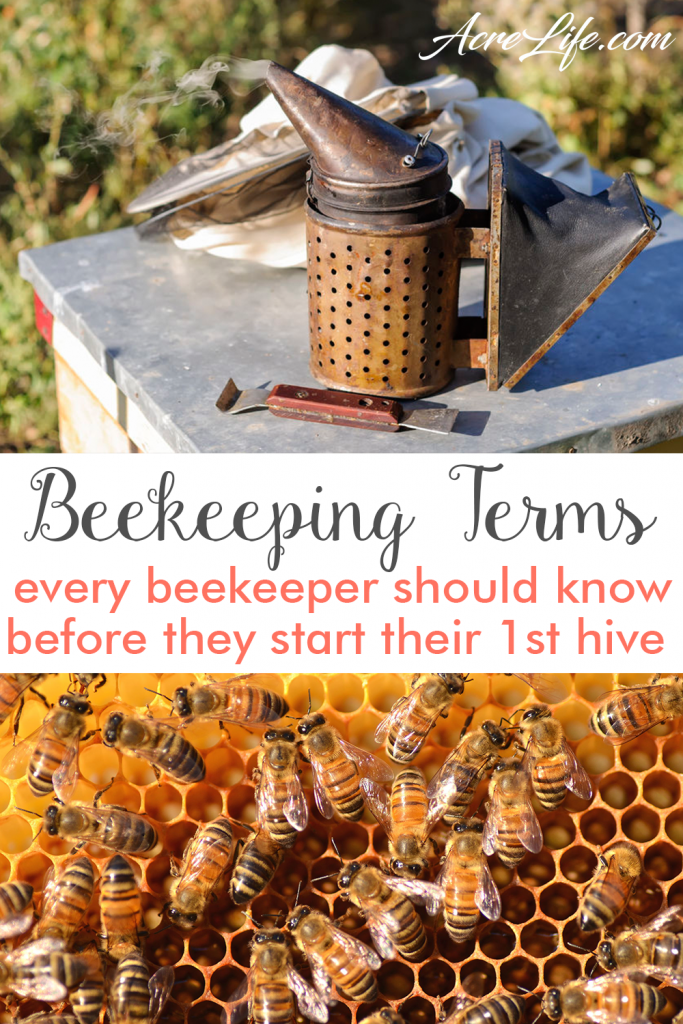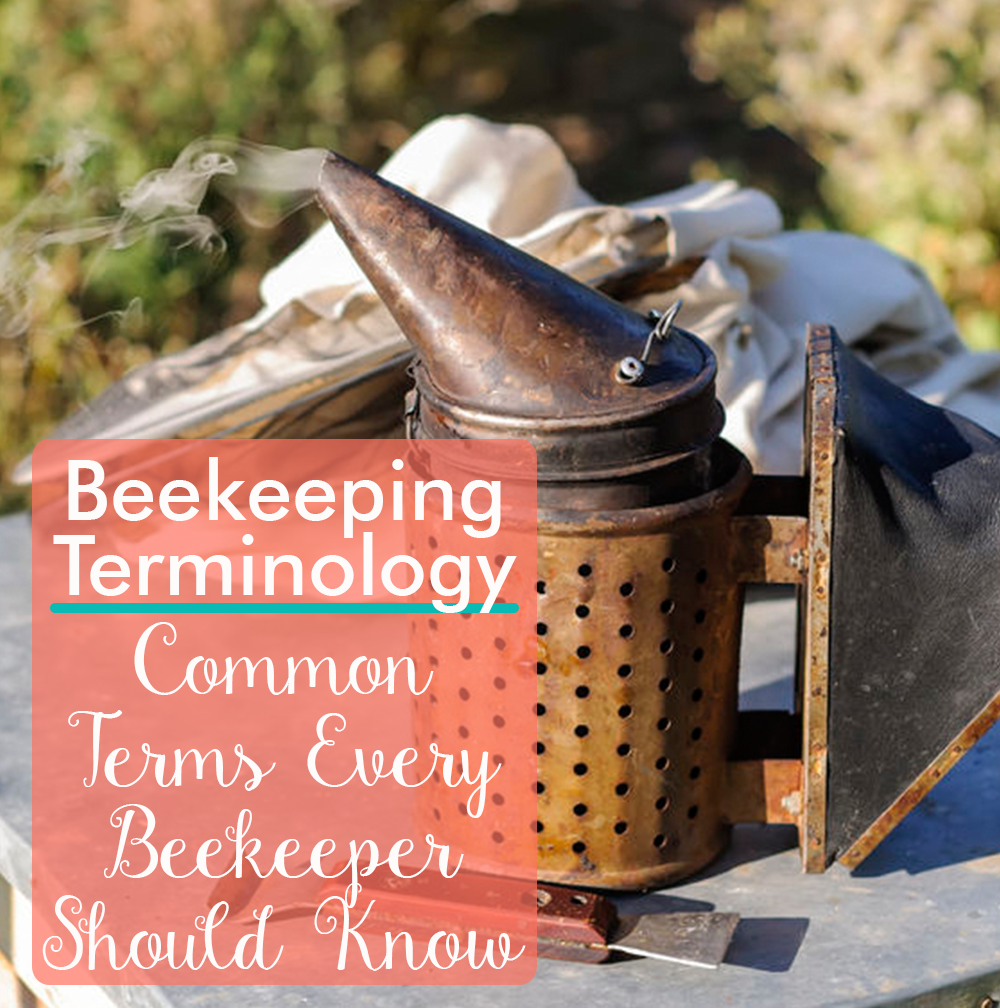Beekeeping Terminology
There are many words that I didn’t know when I first became interested in beekeeping. Here is a list of the common terminology that every beekeeper should know before they get started with their first hive.
Apiary – The place where bees and their hives are kept by a beekeeper. Also called a Bee Yard.
Apiculture – The keeping of bees especially on a large scale.
Bee Bread – Mixture of honey and bitter yellowish-brown pollen stored up in honeycomb cells. Used by nurse bees for feeding the larvae, drones, and queen.
Bee Brush – A soft brush for removing bees from the honeycomb.
Beehive – A container for housing a colony of honeybees.
Bee Space – The space a little less than ¹/₄ inch that provides for the passage of bees in a hive.
Bee Veil – A protective device of fine fabric or wire mesh worn on the head by beekeepers when working with bees.
Beeswax – The substance that is secreted from the abdomen of the worker bee. The bees use this wax to build their comb.
Boardman Feeder – A device for feeding bees that consists of an inverted jar with an attachment allowing access to the hive entrance.
Bottom Board – The floor of a beehive.
Brood – Immature bees in the form of eggs, larvae, or pupae.
Brood Box – Usually the bottom box of the hive containing the brood. Also called the Brood Chamber.
Brood Capping – Worker bees cover the cells of mature pupae with a mixture of wax and hair during their nonfeeding period.
Burr Comb – Small pieces of comb outside of the space that beekeepers want the bees to build the comb.
Cappings – The thin layer of beeswax found over the full cells of honey.
Colony – All of the worker bees, drones, queen, and developing brood living together in one hive.
Comb – A mass of hexagonal wax cells built by honeybees. Built to contain their brood and stores of honey.
Comb Foundation – A man-made structure consisting of thin sheets of beeswax bearing the impression of comb cells on both sides. Inserted into frames by the beekeeper to provide the bees with guidance for how he/she would like them to build the comb.
Drawn Comb – Cells that have been built out by honey bees from the comb foundation in a frame.
Drone – Male honeybee whose main purpose is the impregnate the queen.
Drone Comb – Comb that is made up of larger cells in which drones are reared. Also where honey and pollen are stored.
Dysentery – A condition of adult bees characterized by severe diarrhea. Usually caused by long confinement from poor weather conditions, starvation, or low-quality food. Symptoms: brown or yellow streaks on the front of the hive or freckles visible on white combs only.
Field Bee – Worker bees that collect nectar, pollen, water, and propolis for the colony.
Flight Path – The direction bees fly when leaving their colony and usually in opposite direction returning to their colony. This being the case, don’t point the hive entrance where people are most likely to pass.
Frame – A piece of wood or plastic designed to hold the honeycomb.
Fume Board – a rectangular cover the size of a super which has an absorbent material on the underside. A chemical is placed on the material to drive the bees out of supers for honey removal.
Hive – A container for housing a colony of honeybees.
Hive Tool – A flat metal device with a lifting hook at one end and a flat blade at the other; used to open hives, pry apart and scrape frames.
Honey – a sweet, viscid fluid produced by bees from the nectar collected from flowers and stored in nests or hives as food.
Larva – The second stage of bee metamorphosis; a white, legless, grublike insect.
Nectar – A sweet liquid that is secreted by the nectaries of a plant. It is the chief raw material of honey.
Nuc or Nucleus Hive – A man-made enclosure where a small starter colony of bees is kept until it has grown to a larger colony. A nucleus hive usually contains 2-5 frames.
Nurse Bee – Young bees who feed and take care of the developing brood, the drones, and the queen.
Pollen – The fertilizing element of flowering plants, consisting of fine, powdery, yellowish grains or spores. It is the honeybees source of protein.
Propolis – A brownish resinous material of waxy consistency collected by bees from the buds of trees. Used as a cement in repairing and maintaining the hive.
Pupa – The third stage in the development of the honey bee. When it changes (pupates) from a larva to an adult bee.
Queen – The queen bee is the only reproductive female in the colony. Her head and thorax are similar in size to that of the worker. However, her abdomen is longer and more plump than a worker.
Queen Cell – A special elongated cell in which the queen is reared. It is about an inch or longer and hangs down from the comb in a vertical position.
Robbing – Stealing of nectar, or honey, by bees from other colonies which happens more often during a nectar dearth.
Royal Jelly – A highly nutritious secretion of the pharyngeal glands of the honeybee. Fed to the very young larvae in a colony and to the queen larvae.
Scout Bee – Worker bees searching for a new source of pollen, nectar, propolis, and water.
Smoker – A device in which materials are slowly burned to produce smoke (not flames). Used to subdue bees. It is important to use a material that produces a cool smoke as not to harm the bees.
Super – A hive body or box normally placed above the brood chamber. Used for the storage of surplus honey which the beekeeper will harvest.
Swarm – A large number of honeybees and their queen leaving the hive to start a new colony elsewhere.
Worker Bee – A female bee whose reproductive organs are undeveloped. Workers collect nectar, pollen, water and propolis and rear brood and carry out most other colony duties. Worker bees make up the vast majority of bees in a normal and healthy colony.






As a beehive educator, it has come to my attention that the new bee keepers have the most trouble with keeping up with terms more than the hive work. Super, brood chamber, boxes, hive body, honey super, small, shallow, medium and large super all refer to the same hive box in the service of the hive. In a lecture care needs to be taken to consistently use the correct term. Or you confuse rather than educate.